Opioid medications serve an essential role in modern medicine by providing relief to those suffering from severe and chronic pain. Known for their efficacy, these drugs often become a lifeline for individuals contending with debilitating conditions. However, along with their pain-relieving properties comes a formidable array of dangers, including addiction, harsh withdrawal symptoms, and a significant risk of overdose. The juxtaposition of relief and risk has created a crisis in public health, with many individuals left grappling with dependence and its adverse effects.
The opioid epidemic has necessitated urgent innovations in pain management strategies. While traditional opioid drugs, like morphine, work by activating specific receptors in the brain that mitigate pain, their widespread usage has led to devastating consequences. This complex issue has propelled researchers to seek alternatives that can provide effective pain relief without the heavy toll on individuals’ health.
Charting a New Course in Opioid Research
A recent study published in ACS Central Science uncovers exciting advances toward developing safer opioid alternatives. Researchers have tapped into the unconventional potential of opioids that operate differently from traditional mechanisms. Instead of solely focusing on the classical pathway—the area where most opioids bind to receptors—scientists have redirected their efforts to explore molecules that interact with distinct sites on these receptors.
This fresh perspective has produced promising experimental compounds, including an innovative molecule named RO76. Derived from fentanyl, RO76 stands out because it binds to a far less conventional location on the opioid receptor. What makes this discovery so compelling is its observed ability to suppress pain effectively while simultaneously mitigating some of the most dangerous side effects tied to opioid use.
Revealing RO76: A Game-Changer?
In a series of carefully designed experiments, researchers assessed how RO76 performed against typical opioids like morphine. Their findings were remarkable: RO76 demonstrated a comparable ability to alleviate pain in animal models without significantly slowing down respiration rates—a common and often fatal side effect of traditional opioids. This characteristic could represent a pivotal shift in the landscape of opioid medications.
By taking an innovative route that emphasizes receptor interaction beyond the conventional active sites, RO76 might enable a safer pathway for pain management. Additionally, the compound showed promising results in terms of withdrawal symptoms when the test subjects were administered an opioid-blocking medication, underscoring its potential flexibility and efficacy as an alternative treatment.
Future Implications for Pain Management
The implications of these findings extend far beyond just theoretical knowledge. Should RO76 or similar molecules continue to demonstrate safety and effectiveness in human trials, we may witness a significant transformation in how chronic pain is managed. The potential to develop RO76 as an oral medication means greater accessibility for patients and a more controlled environment for administering pain relief, reducing the likelihood of depersonalized settings like injections.
Moreover, a world where patients can manage their pain effectively without succumbing to addiction or facing life-threatening side effects could signal a major victory in public health. The careful balancing act between providing relief and minimizing risk might finally tip in favor of patient safety.
Overcoming Barriers in Opioid Development
Despite these promising results, challenges remain. The initial discovery of RO76 brings to light the administrative and regulatory hurdles that will accompany its potential introduction to the market. Drug development is fraught with obstacles, each requiring careful navigation, rigorous testing, and comprehensive evaluations. The need for federal agencies to prioritize and streamline the approval processes for such innovations might play a crucial role in addressing the ongoing opioid crisis.
The scientific community’s commitment to finding novel pathways to manage pain is commendable and desperately necessary. While time will tell the extent of RO76’s potential, there’s hope that it might pave the way for an era where safe, effective pain relief is widely available, marking a significant departure from the dark history associated with traditional opioids. The fight for better, safer alternatives not only embodies the essence of scientific progress but also speaks directly to our shared humanity in combating pain and suffering.

